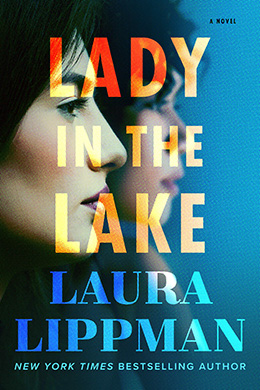One year after releasing Sunburn – her slim and deft ode to the noir aesthetic – Laura Lippman once again pivots to provide readers with something completely different, something that defies categorization, something utterly beguiling. Make no mistake, Lady in the Lake is indeed a crime novel, but that element is really the least of its offerings. Lady in the Lake is a story of a city at a specific time, a story of a city’s population during transition, and a story of one woman’s journey toward self-awareness and independence – all woven together against the backdrop of the newspaper industry, touching on gender and racial politics at every unexpected turn. It is to Laura Lippman’s credit that all of this is managed while never being anything less than completely entertaining.
Lady in the Lake features Madeline Schwartz, a woman at a crossroads in her life during the 1960s. Unfulfilled by her marriage and suburban existence, Maddie runs off to the city to forge her own way. Through her work with a Baltimore newspaper, she uncovers a murder that seems to have gone under-investigated by the local police – largely because the victim was a black woman – and she takes it as her mission to bring the crime (both the murder itself and the authority’s flippancy regarding it) to light and in doing so discovers yet another murder. Meanwhile, her budding relationship with a black police officer is making a bigger statement than she intended and brings her more risk than she ever imagined.

With each alternating chapter in the first two-thirds of the novel, Laura Lippman “interrupts” Madeline’s story to present a portrait of one of the citizens of Baltimore. Each of these point-of-view character profiles flows organically from the main storyline, but the details of their lives are really incidental to the plot. This does not, however, imply that they are unimportant, insignificant, or boring. In fact, just the opposite is the case. Each of these individuals helps to flesh out the reality of Baltimore during this historical time period. Each reads like a first-person short story, gripping in its details and revelations, calling to mind that old adage: “Everyone has a story.”
There is also another voice that occasionally takes center stage. That of Cleo Sherwood – the young black victim Maddie finds herself obsessed with. Cleo’s ghost is less than thrilled with the interference, thinking it too little too late. But is there more to that story? This supernatural element, while non-traditional, works extremely well in the structure of this novel. When Cleo Sherwood first makes her afterlife appearance, readers of classic fiction may harken back to that moment when the dead mother – Addie Bundren – “speaks” in William Faulkner’s As I Lay Dying. Rest assured, just as with that author’s skilled hand, this is not some gimmick employed by a novice author. Cleo Sherwood is an integral part of the Baltimore landscape Laura Lippman is word-painting and it is vital that readers are privy to her own voice, in as authentic a way as possible.
Laura Lippman has long been considered a preeminent chronicler of Baltimore life, but Lady in the Lake feels like a crowning achievement in that realm. The novel also feels like Lippman’s most personal novel-to-date. With her own background in the newspaper industry (and that of her father), this is a topic she is intimately knowledgeable about – and it shows. Expect wide-spread acclaim for Lady in the Lake.
BUY LINKS: Lady in the Lake by Laura Lippman
______________________________________________________________________
Disclaimer: A print galley of this title was provided to BOLO Books by the publisher. No review was promised and the above is an unbiased review of the novel.
